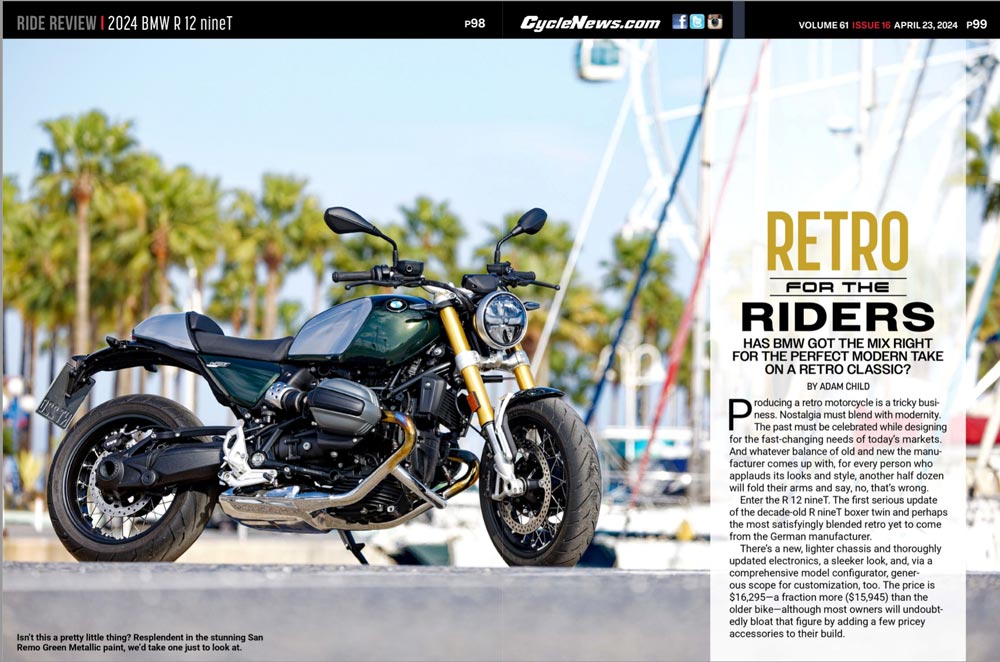| April 26, 2024
Producing a retro motorcycle is a tricky business. Nostalgia must blend with modernity. The past must be celebrated while designing for the fast-changing needs of today’s markets. And whatever balance of old and new the manufacturer comes up with, for every person who applauds its looks and style, another half dozen will fold their arms and say, no, that’s wrong.
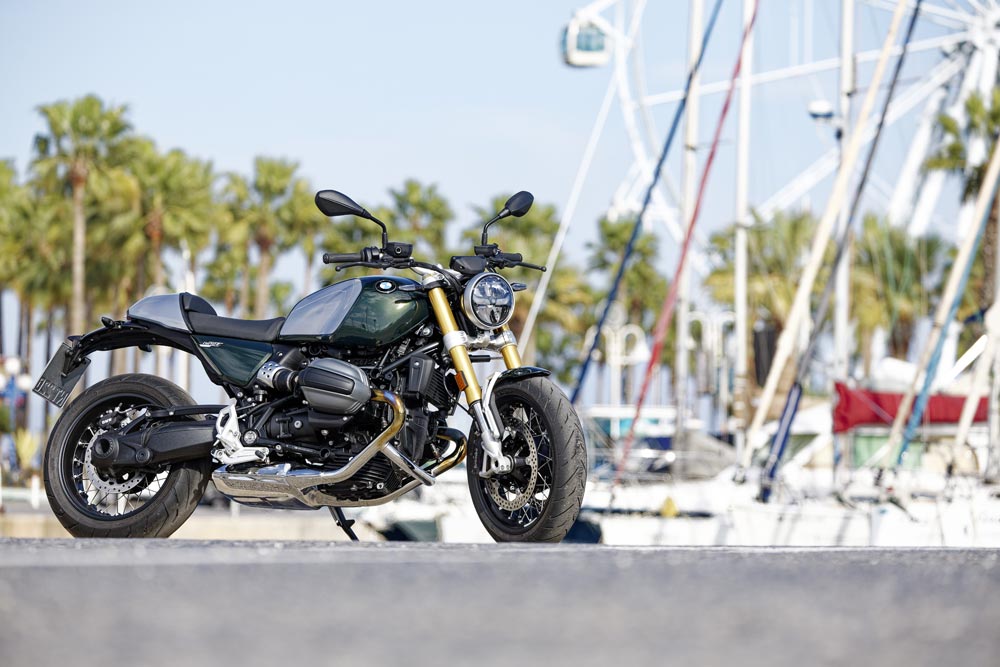 Isn’t this a pretty little thing? Resplendent in the stunning San Remo Green Metallic paint, we’d take one just to look at.
Isn’t this a pretty little thing? Resplendent in the stunning San Remo Green Metallic paint, we’d take one just to look at.
By Adam Child
Enter the R 12 nineT. The first serious update of the decade-old R nineT boxer twin and perhaps the most satisfyingly blended retro yet to come from the German manufacturer.
There’s a new, lighter chassis and thoroughly updated electronics, a sleeker look, and, via a comprehensive model configurator, generous scope for customization, too. The price is $16,295—a fraction more ($15,945) than the older bike—although most owners will undoubtedly bloat that figure by adding a few pricey accessories to their build.
To give you an idea, our test bike featured a host of options that included the Select Package (gearshift assist pro, heated grips, cruise control, hill start control, connected ride control: $1524), classic spoked wheels ($695), a single seat hump ($375) and a digital dash ($145), making for a price of $20,054, including the stunning San Remo Green Metallic paint that adds $325 to the final invoice. Go for the Option 719 aluminum package, and you’ll be forking out no less than $2275 more.
Amid all this change and demand for customization is the small matter of an 1170cc air-cooled boxer engine, which, with BMW celebrating its centenary year, can be traced all the way back to 1923.
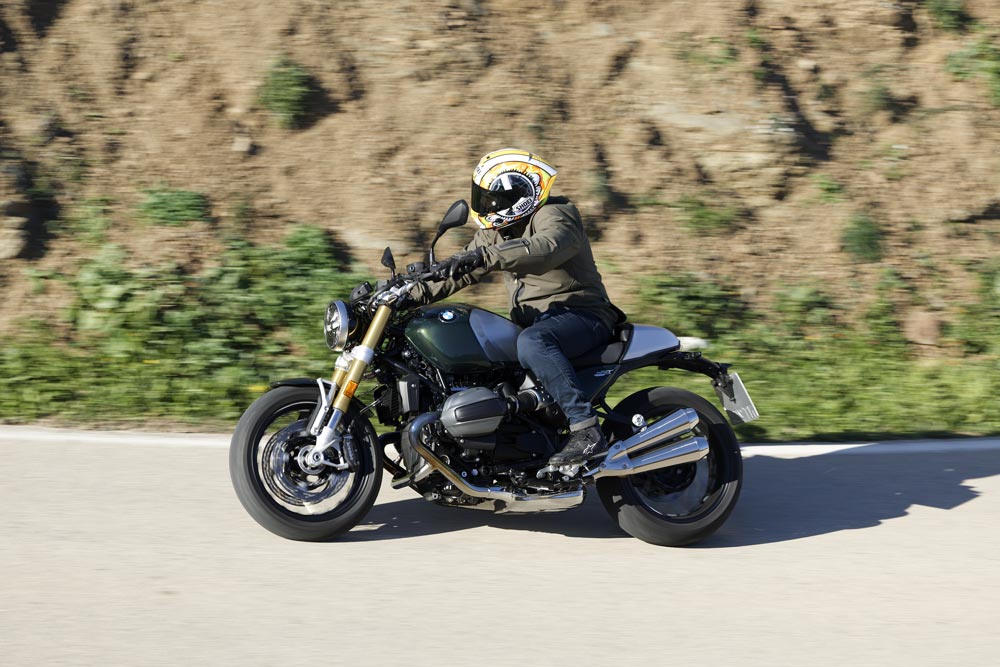 Retro, though it may be, the R 12 can hustle along at a fair clip without grinding the footpegs to dust.
Retro, though it may be, the R 12 can hustle along at a fair clip without grinding the footpegs to dust.
What is old is new | 2024 BMW R 12 nineT Review
On start-up, there’s still that timeless boxer rocking movement at idle as the venerable shaft-driven twin warms its cooling fins, followed by a trademark bark when the throttle is blipped. It makes you realize how refined and smooth modern, liquid-cooled BMW boxers have become and also appreciate the character and mechanical feel of the older design.
Peak power remains at the R nineT’s mark of 109 horsepower but arrives 250 rpm sooner, with peak torque now at 84.8 lb-ft at 6500 rpm, which is 0.7 lb-ft less and 500 rpm higher in the rev range.
Changes to the four-valves-per-cylinder DOHC unit are minimal, although a new airbox is positioned under the seat to eliminate the air intake duct that ran down the right-hand side of the R nineT’s tank, and the standard exhaust is also redesigned.
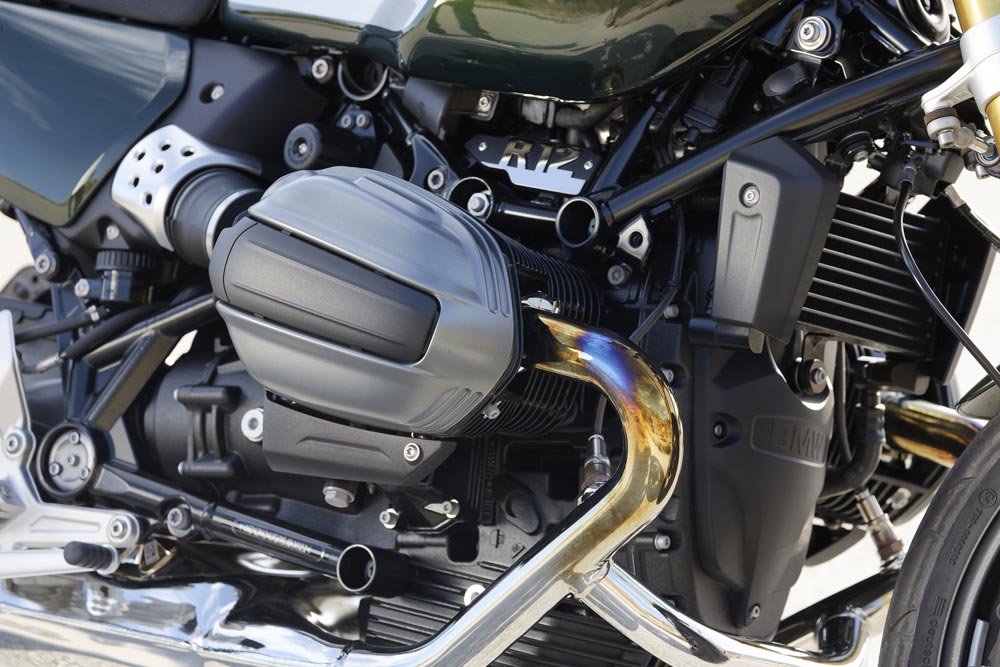 Its 109 horsepower isn’t a lot to write home about for an 1170cc motor, but there’s plenty of torque (85 lb-ft) to go with it.
Its 109 horsepower isn’t a lot to write home about for an 1170cc motor, but there’s plenty of torque (85 lb-ft) to go with it.
Once on the move, the age and character of the boxer continue to show. There’s a slight pull from the shaft drive under heavy acceleration, and despite having an optional quickshifter fitted for the first time, the gearbox is hardly quick or slick by modern standards. The fueling, however, is perfect—soft and sweetly metered in Road and Rain modes, with Dynamic mode adding urgency to throttle inputs without being overly aggressive—while improvements to low- and mid-range drive make a noticeable difference over the older bike.
The drive from as low as 2000 rpm is now as clean as it is enormously strong. Even short shifting at just 4000 rpm results in an old-school Bavarian surge that straightens arms in a very special way. Hustling the R 12 nineT through mountain passes in southern Spain was a torque-fueled joy. I simply left the new quickshifter alone and ran a couple of gears too high, the rich and all-enveloping torque making life so easy.
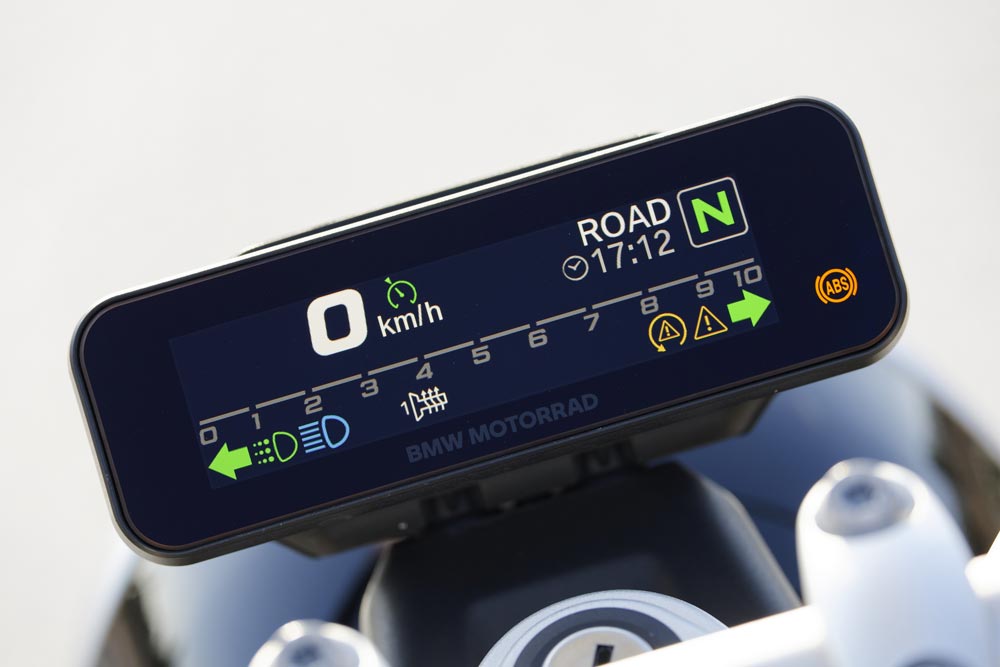 The accessory dash left us a bit cold. We prefer good old analog clocks for a bike of this ilk.
The accessory dash left us a bit cold. We prefer good old analog clocks for a bike of this ilk.
The R 12 likes a few revs, too, and can deliver a decisive turn of speed for a fast overtake. Switch off the traction control (do-able on the move), and it will happily pop the front wheel up with nonchalant ease.
If this all sounds familiar, the same can’t be said of the chassis, which is fully refreshed for 2024. The frame is lighter, although, at 485 pounds wet, the R 12 nineT is only 2.2 pounds lighter than the R nineT. The wheelbase goes out from 58.54 inches to 59.48 inches, and the steering relaxes a little with a new rake angle of 27.7 degrees compared to the R nineT’s 26.8 degrees.
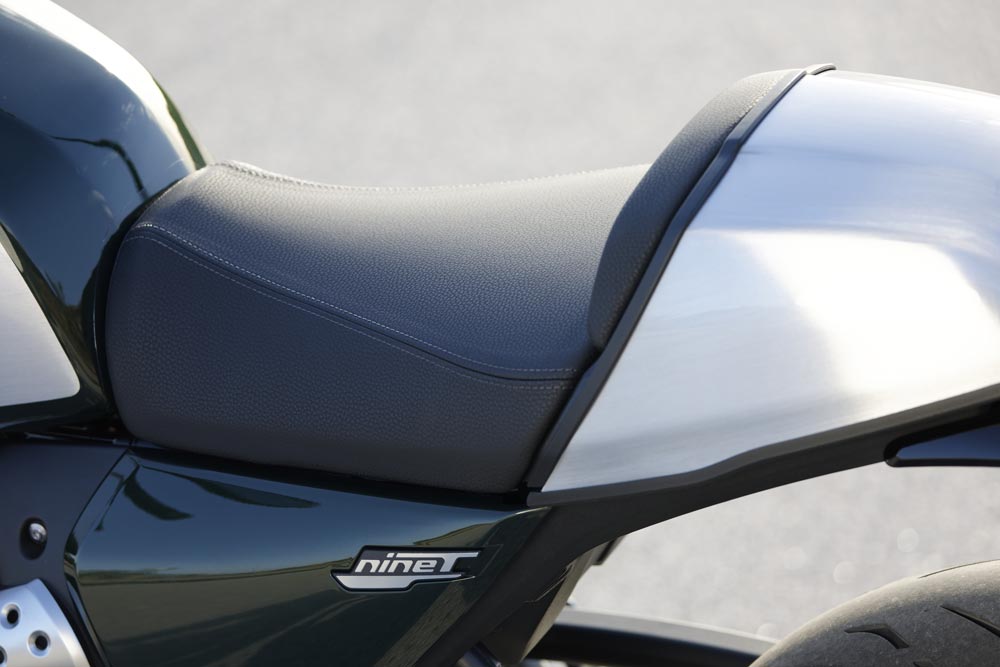 Despite its racy look, the seat is surprisingly comfortable over a full day’s riding.
Despite its racy look, the seat is surprisingly comfortable over a full day’s riding.
The front suspension features a similar but smaller diameter 45mm upside-down fork while the directly connected rear shock is now mounted at an angle rather than upright. BMW’s cornering ABS/ABS Pro is standard, while the brakes themselves are four-piston radial monobloc calipers and twin 310mm discs at the front, with a two-piston caliper and 265mm disc at the rear.
A Spanish sojourn | 2024 BMW R 12 nineT Review
On the road, the chassis mirrors the languid feeling of the motor. It’s not pin-sharp or fast steering. Instead, it rolls into corners and finds natural flow. Stability is as absolute as you’d expect from a long-wheelbase machine with relaxed steering geometry, while the weight distribution and balance feel spot-on for a spirited but controlled ride.
Don’t be fooled into thinking this Heritage Beemer is exclusively for sensible folk, though, because, like its motor, the chassis is capable of delivering a surprisingly sporty ride. Unlike other bikes in this class, ground clearance is good and, while the suspension is set for a comfortable ride, it is certainly not too soft or lacking control.
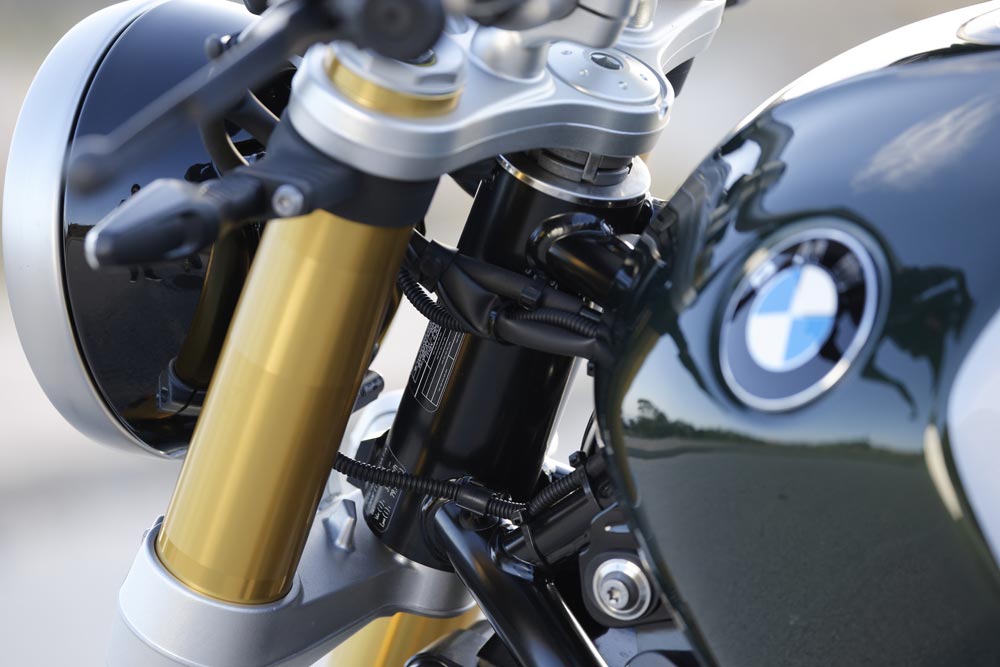 Attention to detail on the R 12 is spot-on.
Attention to detail on the R 12 is spot-on.
At 485 pounds (not including the rider) there is a fair amount of weight for the brakes to manage but they have loads of feel and stopping power, while intervention from the cornering ABS is minimal, no matter which of the two dry-weather riding modes is selected.
Talking of weight, 485 pounds might sound a little intimidating to smaller riders but the R 12 nineT’s mass is carried typically low in the chassis, giving a lovely low-speed feeling and balance. At 31.3 inches the seat is lower than the old model’s 31.7 inches, while the reshaped tank is also 1.2 inches shorter and places the rider closer to the 34.25-inch-wide handlebar, enhancing the rider’s connection with the front tire. I felt instantly at home and was comfortable for several hours in the saddle.
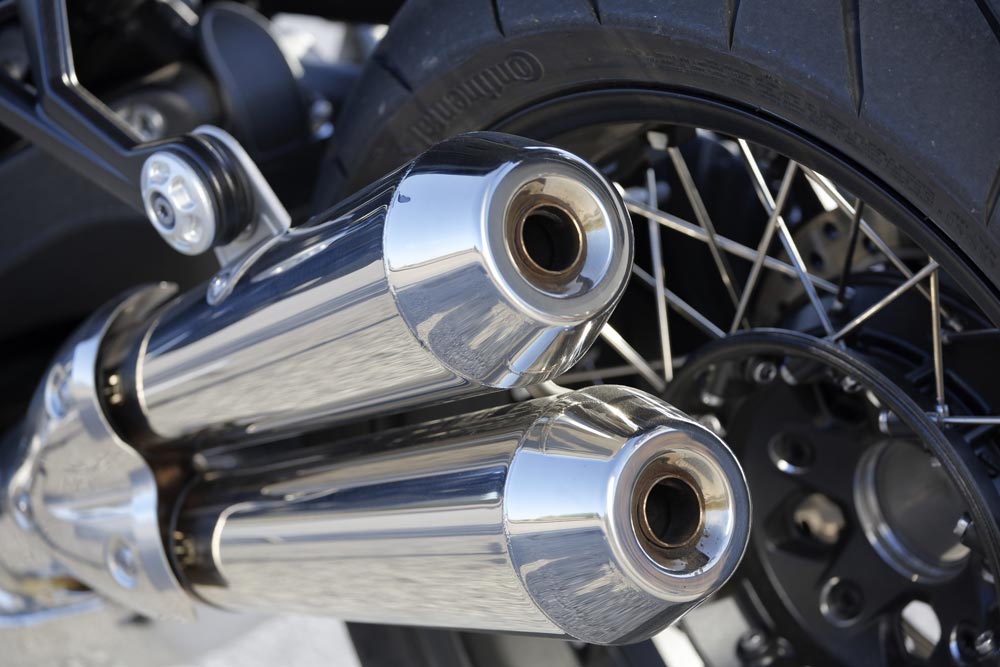 Those pipes are impossible not to love. Chrome, retro, beautiful.
Those pipes are impossible not to love. Chrome, retro, beautiful.
Tick the optional comfort extras on the configurator, and, with cruise control especially, there’s no reason why you can’t take on 300 miles in a day or more. On test, our bike returned over 41.6 mpg, meaning it should get close to 200 miles between fuel stops if speeds are kept legal-ish.
As mentioned, the factory options are seemingly limitless. Our test bike came with the optional 3.5-inch TFT dash, but I’d prefer the standard analog clocks for a retro machine of this type, and while the R 12’s keyless ignition is useful, you still need to use a key for the fuel cap. Overall the standard of equipment is very high, and the level of finish is superb and, of course, while other manufacturers in this class work hard to try to disguise their bikes’ radiators, BMW does not. The look is clean.
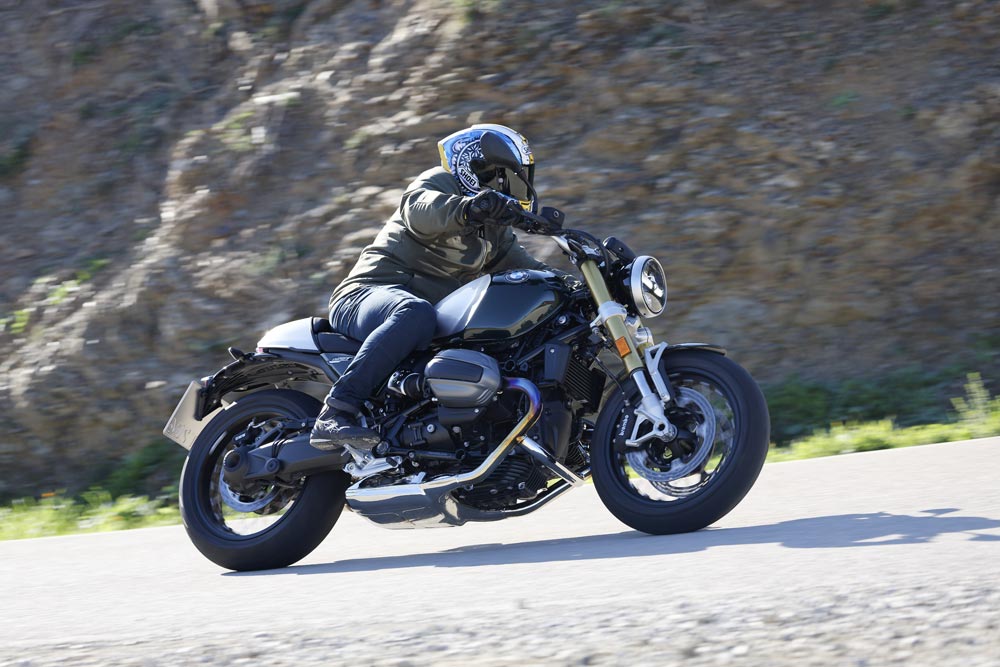 Passengers need not apply.
Passengers need not apply.
Verdict | 2024 BMW R 12 nineT Review
Admittedly, some potential customers are not going to enjoy the R 12 nineT. The rocking movement of the motor, the pull of the shaft drive, and a gearbox that isn’t the quickest won’t impress everyone. But, for many, a little personality, just like we had in the old days, will only be a good thing.
Furthermore, once you adapt to its quirks, it’s an easy bike to ride. Superbly fueled, it’s enriched with torque from the very bottom of the rev range and can give much faster bikes a scare when let off its ultra-cool retro leash. Meanwhile, the revised chassis makes shorter riders welcomed, and the bike can hustle like all the best boxers and does so without dragging its pegs or pipe on the road.
Yes, the R 12 nineT is an expensive motorcycle. Personalize it with a few options (and let’s face it, who wouldn’t want to?), and you are into serious money. But at least you can see where the money has been spent. Some won’t get it, but in a class where authenticity is the most valuable commodity of all, the quality, character, and mechanical intimacy of this air-cooled boxer will be exactly what many want from a retro.CN
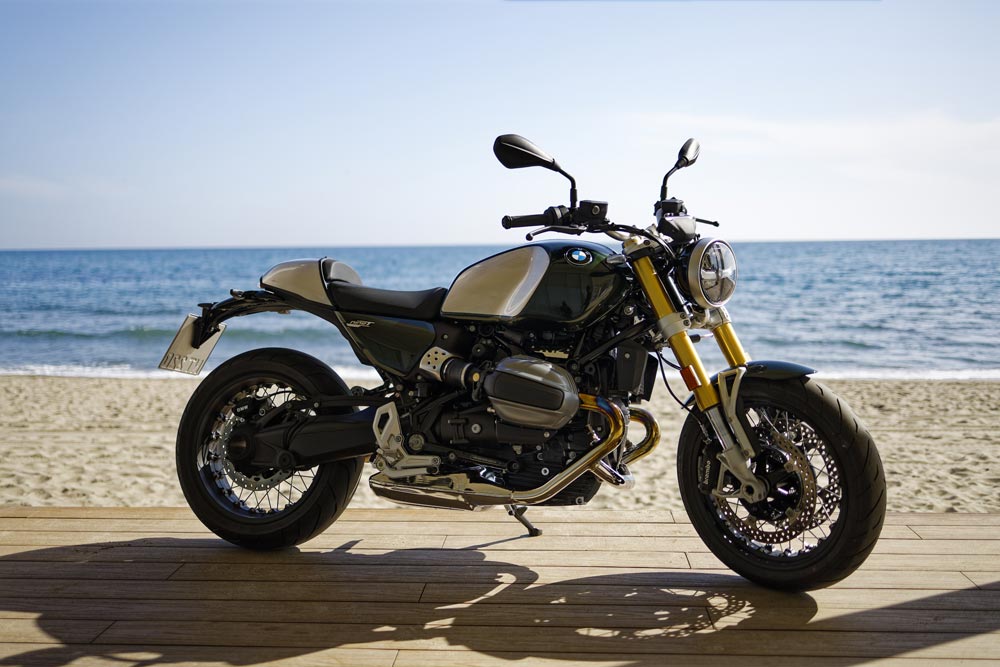
2024 BMW R 12 nineT Specifications
| MSRP: |
$16,295 |
| Engine: |
Boxer twin-cylinder, 4-stroke w/ central counterbalance shaft |
| Displacement: |
1170cc |
| Bore x stroke: |
101 x 73mm |
| Valvetrain: |
2 overhead camshafts, 4 radially arranged valves |
| Cooling system: |
Air/oil |
| Fuel injection: |
Electronic fuel injection system |
| Max Power: |
109 hp at 7000rpm |
| Max Torque: |
85 lb-ftat 6500rpm |
| Exhaust: |
2-1 |
| Transmission: |
6-speed |
| Clutch: |
Wet, multi-plate, slip and assist |
| Electronics: |
Riding Modes, Cornering ABS, Traction Control as standard |
| Chassis: |
Tubular space frame |
| Front suspension: |
Upside-down, 45mm diameter, fully adjustable, 4.7 in. travel |
| Rear suspension: |
Single rear shock, preload and rebound damping 4.7 in. travel |
| Front-wheel travel: |
4.7 in. |
| Rear-wheel travel: |
4.7 in. |
| Front brake: |
Twin disc brake, diameter 310mm, 4-piston monobloc caliper |
| Rear brake: |
Single disc brake, diameter 265mm, 2-piston floating caliper |
| Front tire: |
120/70 ZR17 in. |
| Rear tire: |
180/55 ZR17 in. |
| Wheelbase: |
59.5 in. |
| Trail: |
4.35 in. |
| Head angle: |
62.3° |
| Seat height: |
31.3 in. |
| Fuel capacity: |
3.2 gal. |
| Weight (wet): |
485 lbs. |
